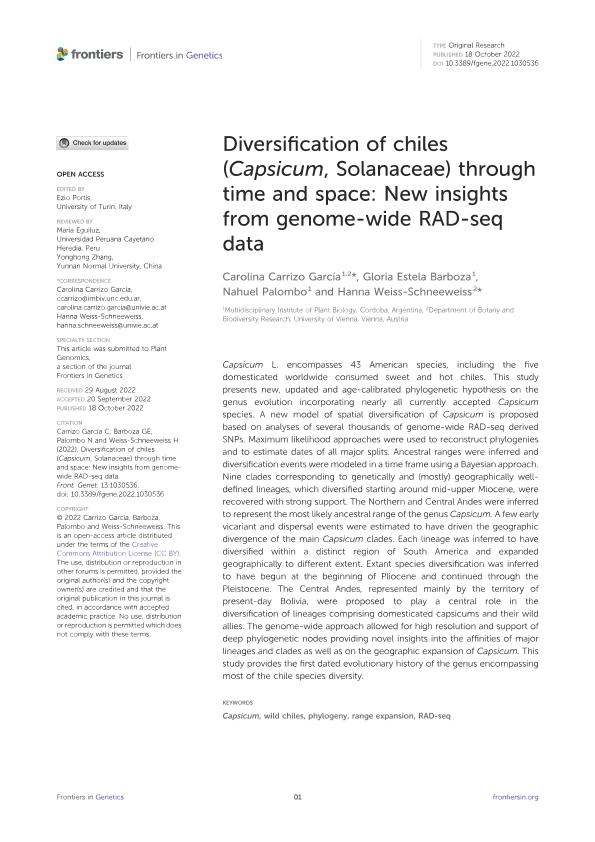Mostrar el registro sencillo del ítem
dc.contributor.author
Carrizo Garcia, Carolina

dc.contributor.author
Barboza, Gloria Estela

dc.contributor.author
Palombo, Nahuel Ezequiel

dc.contributor.author
Schneeweiss, Hanna

dc.date.available
2023-07-27T16:07:17Z
dc.date.issued
2022-10
dc.identifier.citation
Carrizo Garcia, Carolina; Barboza, Gloria Estela; Palombo, Nahuel Ezequiel; Schneeweiss, Hanna; Diversification of chiles (Capsicum, Solanaceae) through time and space: New insights from genome-wide RAD-seq data; Frontiers Media S.A.; Frontiers in Genetics; 13; 10-2022; 1-14
dc.identifier.uri
http://hdl.handle.net/11336/205840
dc.description.abstract
Capsicum L. encompasses 43 American species, including the five domesticated worldwide consumed sweet and hot chiles. This study presents new, updated and age-calibrated phylogenetic hypothesis on the genus evolution incorporating nearly all currently accepted Capsicum species. A new model of spatial diversification of Capsicum is proposed based on analyses of several thousands of genome-wide RAD-seq derived SNPs. Maximum likelihood approaches were used to reconstruct phylogenies and to estimate dates of all major splits. Ancestral ranges were inferred and diversification events were modeled in a time frame using a Bayesian approach. Nine clades corresponding to genetically and (mostly) geographically well-defined lineages, which diversified starting around mid-upper Miocene, were recovered with strong support. The Northern and Central Andes were inferred to represent the most likely ancestral range of the genus Capsicum. A few early vicariant and dispersal events were estimated to have driven the geographic divergence of the main Capsicum clades. Each lineage was inferred to have diversified within a distinct region of South America and expanded geographically to different extent. Extant species diversification was inferred to have begun at the beginning of Pliocene and continued through the Pleistocene. The Central Andes, represented mainly by the territory of present-day Bolivia, were proposed to play a central role in the diversification of lineages comprising domesticated capsicums and their wild allies. The genome-wide approach allowed for high resolution and support of deep phylogenetic nodes providing novel insights into the affinities of major lineages and clades as well as on the geographic expansion of Capsicum. This study provides the first dated evolutionary history of the genus encompassing most of the chile species diversity.
dc.format
application/pdf
dc.language.iso
eng
dc.publisher
Frontiers Media S.A.
dc.rights
info:eu-repo/semantics/openAccess
dc.rights.uri
https://creativecommons.org/licenses/by-nc-sa/2.5/ar/
dc.subject
CAPSICUM
dc.subject
PHYLOGENY
dc.subject
RAD-SEQ
dc.subject
RANGE EXPANSION
dc.subject
WILD CHILES
dc.subject.classification
Ciencias de las Plantas, Botánica

dc.subject.classification
Ciencias Biológicas

dc.subject.classification
CIENCIAS NATURALES Y EXACTAS

dc.subject.classification
Biología

dc.subject.classification
Ciencias Biológicas

dc.subject.classification
CIENCIAS NATURALES Y EXACTAS

dc.title
Diversification of chiles (Capsicum, Solanaceae) through time and space: New insights from genome-wide RAD-seq data
dc.type
info:eu-repo/semantics/article
dc.type
info:ar-repo/semantics/artículo
dc.type
info:eu-repo/semantics/publishedVersion
dc.date.updated
2023-07-07T18:59:08Z
dc.identifier.eissn
1664-8021
dc.journal.volume
13
dc.journal.pagination
1-14
dc.journal.pais
Suiza

dc.description.fil
Fil: Carrizo Garcia, Carolina. Consejo Nacional de Investigaciones Científicas y Técnicas. Centro Científico Tecnológico Conicet - Córdoba. Instituto Multidisciplinario de Biología Vegetal. Universidad Nacional de Córdoba. Facultad de Ciencias Exactas Físicas y Naturales. Instituto Multidisciplinario de Biología Vegetal; Argentina. Department Of Botany And Biodiversity Research; Austria
dc.description.fil
Fil: Barboza, Gloria Estela. Consejo Nacional de Investigaciones Científicas y Técnicas. Centro Científico Tecnológico Conicet - Córdoba. Instituto Multidisciplinario de Biología Vegetal. Universidad Nacional de Córdoba. Facultad de Ciencias Exactas Físicas y Naturales. Instituto Multidisciplinario de Biología Vegetal; Argentina
dc.description.fil
Fil: Palombo, Nahuel Ezequiel. Consejo Nacional de Investigaciones Científicas y Técnicas. Centro Científico Tecnológico Conicet - Córdoba. Instituto Multidisciplinario de Biología Vegetal. Universidad Nacional de Córdoba. Facultad de Ciencias Exactas Físicas y Naturales. Instituto Multidisciplinario de Biología Vegetal; Argentina
dc.description.fil
Fil: Schneeweiss, Hanna. Department Of Botany And Biodiversity Research; Austria
dc.journal.title
Frontiers in Genetics
dc.relation.alternativeid
info:eu-repo/semantics/altIdentifier/url/https://www.frontiersin.org/articles/10.3389/fgene.2022.1030536/full
dc.relation.alternativeid
info:eu-repo/semantics/altIdentifier/doi/http://dx.doi.org/10.3389/fgene.2022.1030536
Archivos asociados
